 |
|
        |
|
|
|
Children’s Books
|
|
| |
|
|
|
|
|
|
|
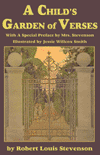
ISBN:
978-1-61720-048-9


 |
A
Child's Garden of Verses
with
a
special preface by Mrs. Stevenson
written
by Robert Louis Stevenson,
Illustrated by Jessie Wilcox
“Why,” said a
child listening to Stevenson’s poems, “he did all the things that we
do!”
These famous poems of childhood owe much of their luminous
understanding of children’s play and imagination to the limited
childhood spent by Stevenson. Kept indoors during the winter by his
health, he learned to notice all the things about him and to live in a
world of imagination. In bed he listened to stories told by his nurse,
and he looked out the window to see other children at play, or to
watch, with fascination the lamplighter coming to the street light near
his house. Summer was a more joyous time, for then he could be
out-of-doors, and his poems of outdoor play reflect the joy of sailing
boats and playing in the meadow with his cousins.
One feature of Stevenson’s poems that is sometimes forgotten is their
humor. A gentle, satiric humor such as: “A child should always say
what’s true, And speak when he is spoken to, And behave mannerly at
table: At least as far as he is able.”
Included in this special edition is a biographical preface written by
his wife, Fanny Van De Grift Stevenson.
“A Child’s Garden of
Poems” was originally published in 1892. This edition
contains all 67 poems, all 86 black-and-white illustrations, and all 13
of original illustrations by Jessie Wilcox Smith (including the
original title-page illustration from the 1905 edition.
|
|
|
|
|
|
|
|
“The
Sea Fairies” and “Sky
Island”, by L. Frank Baum, the author of the
famous Oz series (“The
Emerald City of Oz,” “Dorothy and the Wizard in
Oz,” etc.), were the beginning of a new series of
children’s books.
Mayre
Griffiths, nicknamed Trot, or sometimes Tiny Trot, is a
little girl who lives on the coast of southern California. Her father
is the captain of a sailing schooner, and her constant companion is
Cap’n Bill Weedles, a retired sailor with a wooden leg. Trot and Cap’n
Bill spend many of their days roaming the beaches near home, or rowing
and sailing along the coast.
In “The Sea Fairies”
Trot wishes
that she could see a mermaid; her wish is overheard, and granted the
next day. The mermaids explain to Trot, and Cap’n Bill, that they are
benevolent fairies; when they offer Trot a chance to pay a visit to
their land in mermaid form, Trot is enthusiastic, and Bill is too loyal
to let her go off without him. But the evil Magician Zog is after the
mermaids, so what happens when he gets Trot and Cap’n Bill, too?
In “Sky Island” Trot
meets a strange little boy with a large
umbrella. Button -Bright has been using his family’s magic umbrella to
take journeys from his Philadelphia home, and has gotten as far as
California. The two children, joined by Cap’n Bill, decide to take a
trip to a nearby island; they call it “Sky Island,” because it looks
like it’s “halfway in the sky” — but the umbrella takes them to a
different place entirely, a literal island in the sky, where they run
afoul of the mean Blues, find equal problems with the nicer
Pinks, and must fight a war to get back the Magic Umbrella that the
Blues took from them so they can return home.
L.
Frank Baum
thought “Sky Island”
would probably be remembered as his best work.
In
making this volume, we discovered that the Gutenberg eBooks are
missing text, have run-together paragraphs, and the punctuation has
been altered. This volume contains the full text of the original books,
published in 1914, and 1920, respectively, as well as all 164 John R.
Neill illustrations.
|
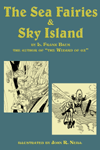
ISBN:
978-1-61720-426-5


 |
|
|
|
|
|
|
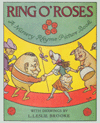
ISBN:
978-1-61720-438-8
|
Never have young
children had a better picture-book introduction to Mother Goose than
this book with its profusely illustrated collection of 21 nursery
rhymes. Brooke’s marvelous draftsmanship and the subtleties
of his illustrations, both color and black-and-white, have a clarity
that will delight both children and adults.
A beautiful book to sit down and enjoy with your child, one that should
be in every child’s own library. Rhymes included are: The Man in the
Moon; To Market, To Market; Simple Simon; There was a Man; The Lion and
the Unicorn; Little Miss Muffet; Oranges and Lemons; Goosey, Goosey
Gander; Humpty Dumpty; Baa, Baa, Black Sheep; The Three Wise Men of
Gotham; This Little Pig Went to Market; Jack and Jill; There was a
Crooked Man; Little Bo-peep; Good King Arthur; There was a Little Man;
Ring O’ Roses; Hickety Pickety My Black Hen; Cock-a-Doodle-Doo; and Wee
Willie Winkie.
Of all the
different editions of this classic, none is more treasured than this
one, with the 32 gorgeous, soft, full-color full-page paintings, and 58
delicate Black-and-White line drawings that all combine to make the
perfect picture-book for young children.
|
|
|
|
|
|
|
|
The
Bobbsey Twins |
|
|
by
Laura Lee Hope |
|
|
|
|
|
|
One
of the longest running story series for children is “The Bobbsey Twins,”
and it has delighted children and their parents for over a hundred
years now. Follow the adventures of two sets of young twins at
the turn of
the Twentieth Century when there were no telephones, radios, and
televisions, and horses and carriages were common. The twins
enjoy wonderful days filled with sunshine and love with their
playmates, Grace, Nellie, and Charlie, and get into and out of trouble
as only little kids can manage.Their cat, Snoop, (and after book
#4
“The Bobbsey Twins at
School,”--in Volume 2 below-- their dog Snap, too) goes
along on many
of their adventures as they build snow houses, ice boats and kites,
explore islands and boats, help their friends, and even save chickens
from a flood!
“The Bobbsey Twins”
is one of the many book series written in the early
20th Century by the Stratemeyer Syndicate. The first book in each
series was written by Edward Stratemeyer, who then produced outlines
for the other books in the series and hired writers to produce the
actual books using a pseudonym. For the Bobbsey Twins’ series this was
Laura Lee Hope. First pubished in 1904, each volume includes the
original
illustrations.
|
|
|
|
|
|
 |
|
|
|
|
|
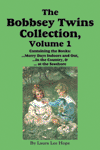
ISBN:
978-1-60459-980-0 |
When “The Bobbsey Twins, or Merry Days
Indoors and Out”
begins in 1904, Bert and Nan are
eight,
and Flossie and
Freddie are four. The twins have many adventures as they build snow
houses, ice
boats and kites, and find a mysterious ghost wandering in their house
at night. Then, in “The Bobbsey Twins in the
Country”,
they take a trip to the country to
visit their Uncle
Daniel and make their own circus, celebrate the Fourth of July, almost
burn down their uncle’s barn, and then help save a neighbor's henhouse
from washing away in a flood! Finally, in “The
Bobbsey Twins at the Seashore”, they
travel to the seashore to
stay at Uncle William"s house where they have more exciting adventures,
including digging up treasure, getting lost in a boat, and
participating
in a parade.
“The Bobbsey Twins, or Merry Days
Indoors and Out” was published in
1904 and written by Edward Stratemeyer; “The Bobbsey Twins in the
Country” and “The
Bobbsey Twins at the Seashore” were both published in
1907 and written by Lilian C. Garis.
|
|
|
|
|
|
|
|
Bert
and Nan are now nine, and Flossie and Freddie are five, as they
continue
their adventures in “The Bobbsey Twins at
School.” Flossie and Freddie are just
starting
school, while Bert
and Nan are going into Fourth Grade and deal with bullies, have sled
races, and find out who set fire
to their boathouse. In “The
Bobbsey Twins at Snow Lodge,” they travel to a lodge in the
country during the school holidays and escape a snow slide, get lost in
the woods, and solve the mystery of Mr. Carford’s missing money.
Finally, in “The Bobbsey Twins on a
Houseboat,”
they spend a summer vacation on a Houseboat that seems to be
haunted, as things keep disappearing from the kitchen! Plus a mean
farmer tries to stop them from taking their houseboat down the river to
the lake. How does Mr. Bobbsey deal with this man, who saves Snap when
the kitten falls into the river, and who saves Flossie when SHE falls
into the river!
“The Bobbsey Twins at
School” and “The
Bobbsey Twins at Snow Lodge” were published in 1913, while “The Bobbsey Twins on a
Houseboat” was published in 1915. All three
were written
by Howard R. Garis.
|
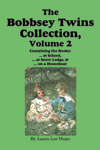
ISBN:
978-1-60459-982-4
|
|
|
|
|
|
|
|
The Six Little
Bunkers |
|
|
by
Laura Lee Hope |
|
|
|
|
|
Another famous series is “The
Six Little Bunkers,” one of the many
children series
written in the early Twentieth Century by the Stratemeyer
Syndicate. These are delightful stories for
little boys and girls which sprang into immediate popularity when they
first appeared in 1918 -- the adventures of the Bunker family in the
early 1900's when there were no passenger airplanes, nor telephones,
radios,
MP3 players, or televisions, and trains, steamers, and horses and
carriages were common-place.
To know the six little
Bunkers is to take them
at once to your heart. Each story has a little plot of its own—one that
can be easily followed—and all are written in a most entertaining
manner. With six small children, Daddy (Charles)
and Mother (Amy) Bunker have their hands full trying to keep track of
their small tribe, with one, two, or three of the little dears always
seeming to wander away or get into the oddest adventures as they visit
their many relatives.
The
oldest of the Bunker children is eight-year-old Russell Bunker (but
everyone calls him Russ) and he is very fond of "making things." Next
is seven-year-old Rose Bunker. Though young she can do some sweeping
and lots of dusting, and is quite a little mother’s helper. Violet, or
Vi, aged six, is a curly-haired girl, with gray eyes, and can ask more
questions than her father and mother can answer. Then there is Laddie,
or Fillmore, Vi’s twin, and he happens to be fond of asking riddles.
After Laddie and Violet come Margy, aged five, and then four-year-old
Mun Bun, the youngest and smallest. Join the fun, and
mischief, as two parents try to keep track,
and control, of six small children who are always exploring everything
around them.
The first book was written by Edward Stratemeyer, who
then produced
outlines for the other books in the series and hired writers to produce
the actual books using a pseudonym. For the “The Six Little Bunkers”
series it was Laura Lee Hope. All the books have the same number of
chapters, twenty-five. Each volume includes the original illustrations.
|
|
|
|
|
|
|
|
 |
|
|
|
|
|
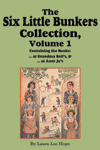 ISBN: ISBN:
978-1-60459-983-1
|
In “The Six Little Bunkers at
Grandma Bell’s”
the Bunker children are thrilled that Grandma Bell has invited them to
visit her home in the woods, but before they go Daddy Bunker
accidentally loses some important papers when he gives an old coat to a
tramp. Then Marrgy almost gets left at the train station,
Rose thinks
her doll has become a real baby, Laddie grabs the wrong daddy at
another station, and when they get to Grandma's house, Russ discovers a
treadmill in Grandma's barn and can't get off once he starts running.
Rose is upset when Russ and Laddie discover a corn shucker and promptly
start
shucking all the buttons off her doll, Margy discovers that the ram
doesn't like her red coat, and they all have fun fishing. And what do
you think happens when Russ and Laddie build a dog-cart for Zip the dog
and start hunting for the tramp who has their daddy's missing papers?
After
leaving Grandma Bell's house, the Bunkers head to Boston to visit their
Aunt Jo, where Mrs. Bunker and Rose find someone's lost pocketbook,
Russ decides to make a fountain the front yard, and Rose makes an
"airship" out of a basket and her brothers' ballons and accidentally
launches her doll Lily skyward. Will she ever get her doll back? Will
they find the pocketbook's owner? And why did Margy climb into the
dumbwaiter?
“The Six Little Bunkers at
Grandma Bell’s” and “The
Six Little Bunkers
at Aunt Jo’s” were published in
1918.
|
|
|
|
|
|
|
|
After their
vacation with Aunt
Jo, the Bunkers head over to Cousin Tom's at the seashore. There the
hunt for buried Pirate treasure, go crab fishing, meet up with a Sallie
Growler, get caught on a sandbar as the tide comes in, and discover and
then lose a wooden shipping box. Will they ever find the mysterious box
again? And what will Violet do when her doll gets lost, and is Rose's
locket lost forever?
Finally they
decide to return home to Pennsylvania, but who is that
waiting for them on their porch? It's Grandpa Ford with a scary mystery
about Great Hedge, the farm he just bought for himself and Grandma.
It's haunted? Off to the country farm the Bunkers go! With adventures
in storms, old spinning wheels, making snowshoes, skates, and
ice-boats, not to mention getting lost in a snowstorm, things are never
dull for the Bunkers. But will they ever solve the mystery of the ghost
haunting Great Hedge?
“The Six Little Bunkers at
Cousin Tom's” and “The
Six Little Bunkers at Grandpa Ford's” were published in
1918.
|
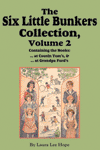
ISBN:
978-1-60459-984-8
|
|
|
|
|
|
|
|
|
|
|
|
|
|
The
“Every Child Should Know”
Library |
|
|
Edited by Hamilton Wright Mabie |
|
|
|
|
|
The “Every Child Should Know”
Library is a collection of the most famous, and popular,
stories,
poems, myths, legends, fairy tales, folk tales, heros, and heroines,
ten books in five volumes for easy reference. These stories,
fables, and
poems, have delighted adults and children for dozens, hundreds, and
even thousands of years, and your child will frequently run into
references of them in popular culture and literature. From Hercules to
Joan of Arc, from the Wynken, Blynken, and Nod to Ozymandias of Egypt,
your child will find the stories and poems fun,
thought-provoking, and a subtle guide to the pillars
of our civilization. |
|
|
|
|
|
|
|
|
|
|
|
 |
|
|
|
|
|
|
|
|
|
|
|
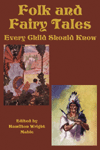 ISBN: ISBN:
978-1-61720-115-8



|
“Folk and Fairy Tales Every Child
Should Know” — In those early days before
magazines or newspapers or books the most learned men were ignorant of
things which intelligent children know to-day. Only a very few men and
women could read or write; and all kinds of beliefs about animals,
birds, witches, fairies, giants, and the magical qualities of herbs and
stones flourished like weeds in a neglected garden. There came into
existence an immense mass of misinformation about all manner of things;
some of it very stupid, much of it very poetic and interesting. Below
the region of exact knowledge accessible to men of education, lay a
region of popular fancies, ideas, proverbs, and superstitions in which
the great mass of men and women lived, and which was a kind of
invisible playground for children. Much of the popular belief about
animals and the world was touched with imagination and was full of
suggestions, illustrations, and pictorial figures which the poets were
quick to use.
“Fairy Tales Every Child Should
Know”
contains a collection of twenty-four famous fairy tales from a wide
array of classical works (Grimm’s Fairy Tales, 1001 Arabian Nights,
Hans Christian Andersen, and others), which most parents have told to
their children throughout time. These tales are immortal and include:
“The Enchanted Stag;” “Puss in Boots;” “Jack and the Beanstalk;” “The
Princess on the Pea;” “The Ugly Duckling;” “Beauty and the Beast;”
“Hansel and Gretel;” “Jack the Giant Killer;” “The Second Voyage of
Sinbad the Sailor;” “The Story of Aladdin, or the Wonderful Lamp,” and
many more. delightful tales.
“Folk Tales Every Child Should
Know” similarly pulls from the rich traditions of
countries all over
the world to deliver twenty classic stories such as: “Why the Sea is
Salt;” “The Dragon and the Prince;” “The Story of Tom Tim Tot;” and
“The Good Children.”
“Fairy Tales Every Child Should
Know” and
“Folk Tales Every Child
Should Know” were originally published in 1905
and 1912, respectively. This volume faithfully reproduces the stories
in those editions, with minor edits to correct some words to a more
modern spelling (i.e, changing traveller to traveler).
|
|
|
|
|
|
|
|
Long years ago
many teachers in central Illinois said: “We want a Kipling book.” The
demand was for a book that could be used in each grade of the public
schools, if possible in the child’s own hands. The use of “The Just So
Stories” and “The Jungle Book” has come more and more into practice
through the importunities of teachers. These books have been entered on
many school lists as “supplementary” reading. This book is intended to
reach the hands of children in lower grades, kindergartens, and
nurseries, by its picture pages, which will be supplemented by the
reading of the text by teachers or parents. This book takes
the best poems and stories from those volumes and presents them here in
one place, providing your child with a wide sample of works from this
famous author. After reading this book, your child will want to see and
hear more stories like those that first caught his, or her, attention.
He, or she, might even be inspired to seek out all the works by
Kipling, greatly broadening the horizons of their reading
experiences.
“Kipling Stories and Poems Every
Child Should Know” is a compilation of Rudyard Kipling’s
“The Jungle Book,” “The Second Jungle Book,” “Just So Stories,”
“Departmental Ditties and Ballads and Barrack Room Ballads,” “The Seven
Seas,” “The Five Nations,” “Under the Deodars,” “The Day’s Work,”
“Captains Courageous,” “Many Inventions,” “The Naulahka,” and “The Just
So Song Book.” * * * * “Kipling Stories and Poems Every Child Should
Know” has appeared in print from Houghton Mifflin Company as a single
book, a two volume set, and a three volume set, all with a publication
date of 1909. This volume faithfully reproduces the illustrations and
stories in those editions, with minor edits to correct some words to a
more modern spelling (i.e, changing traveller to traveler).
“Kipling Stories and Poems Every
Child Should Know” takes the best poems and
stories from those volumes and
presents them here in one place, providing your child with a wide
sample of works from this famous author. After reading this book, your
child will want to see and hear more stories like those that first
caught his, or her, attention. He, or she, might even be inspired to
seek out all the works by Kipling, greatly broadening the horizons of
their reading experiences.
“Kipling Stories and Poems Every
Child Should Know” is a compilation of selected works from
Rudyard Kipling’s “The Jungle
Book,” “The Second Jungle Book,” “Just So Stories,” “Departmental
Ditties and Ballads and Barrack Room Ballads,” “The Seven Seas,” “The
Five Nations,” “Under the Deodars,” “The Day’s Work,” “Captains
Courageous,” “Many Inventions,” “The Naulahka,” and “The Just So Song
Book.”
“Kipling Stories and Poems Every
Child Should Know” has
appeared in print from Houghton Mifflin Company as a single book, a two
volume set, and a three volume set, all with a publication date of
1909. This volume faithfully reproduces the illustrations and stories
in those editions, with minor edits to correct some words to a more
modern spelling (i.e, changing traveller to traveler).
|
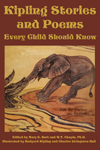
ISBN:
978-1-61720-116-5


 |
|
|
|
|
|
|
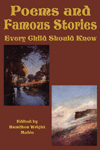 ISBN: ISBN:
978-1-61720-117-2


 |
“Poems and
Famous Stories Every Child Should Know” — Is
this another collection of stupid poems and stories that children
cannot use? Will they look hopelessly through this volume for poems and
stories that suit them? Will they say despairingly, “This is too long,”
and “That is too hard,” and “I don’t like that because it is not
interesting”? Are there three or four pleasing poems and are
all the rest put in to fill up the book? Nay, verily! The poems in this
collection are those that children love. With the exception of seven,
they are short enough for children to commit to memory without wearying
themselves or losing interest in the poem. If one boy learns “The
Overland Mail,” or “The Recruit,” or “Wynken, Blynken, and Nod,” or
“The Song in Camp,” or “Old Ironsides,” or “I Have a Little Shadow,” or
“The Tournament,” or “The Duel,” nine boys out of ten will be eager to
follow him.
“Poems Every Child
Should Know” is a collection of 187 famous poems from a
wide array of classical and modern works, with such favorites
as “Twinkle, Twinkle, Little Star;” “The Owl and the
Pussy-Cat;” “The Village Blacksmith;” “O Captain! My Captain!;” “How
Sleep the Brave;” “Abide With Me;” “A Visit From St. Nicholas;” and
“Ozymandias of Egypt.” The authors include Clement Clarke Moore, Henry
W. Longfellow, Robert Browning, Alfred Tennyson, Oliver Wendell Holmes,
Sir Walter Scott, Rudyard Kipling, William Shakespeare, Walt
Whitman and 94 others. The book also includes an “Author Index” and a
“First Line” index to help locate poems.
“Famous Stories Every Child
Should Know”is a collection of eleven stories: “A Child’s Dream of a Star”
by Charles Dickens; “The
King of the Golden River or, The Black Brothers” by John
Ruskin; “The Snow Image:
A Childish Miracle” by Nathaniel Hawthorne; “Undine” by
Friedrich, Baron De La Motte Fouqué; “The Story of Ruth”
From The Book Of Ruth; “The
Great Stone Face” by Nathaniel Hawthorne; “The Diverting History of John
Gilpin” by William Cowper; “The Man Without a Country”
by Edward Everett Hale; “The
Nürnberg Stove” by Louise De La Ramée (“Ouida”); “Rab and His Friends”
by John Brown, M.D.; and “Peter
Rugg, the Missing M” by William Austin. The
stories collected in this volume have been selected from many sources,
because in the judgment of the editor, they are sound pieces of
writing, wholesome in tone, varied in interest and style, and
interesting. It is his hope that they will not only furnish good
reading, but that they will suggest the kind of reading in this field
that should be within the reach of children.
“Poems Every Child Should Know”
and “Famous Stories
Every Child Should Know” were originally published in 1904
and 1907, respectively. This volume faithfully reproduces the poems and
stories in those editions, with minor edits to the author information,
i.e, where the editor originally indicated the author of a piece was
still living, we included the date of his, or her, death.
|
|
|
|
|
|
|
|
“Myths and Legends Every Child
Should Know” is actually two books in one volume:
“Myths Every Child
Should Know” and “Legends
Every Child Should Know.”
Both books are compilations of important myths and legends that have
been passed down from storyteller to storyteller for thousands of
years, and hold stories that, literally, every child should know. As
your child grows older, he or she will constantly run into references
to characters, items, and situations present in these stories. Things
like “the Midas touch” turning everything to gold, being a
Rip
Van Winkle and missing things everyone else knows about, or any
reference to Pandora’s box. While these stories vary greatly in
details; they fit every climate and wear the peculiar dress of every
country; it is easy to see that they are made up of the same materials,
and they describe the same persons or ideas or things whether they are
told in Greece or India or Norway or Brittany. Wherever they are found
they make it certain that they come from a very remote time and grew
out of ideas or feelings and ways of looking at the world which a great
many men shared in common in many places. These stories were selected
by H.W. Mabie because they throw light on the mind and character of the
ages that produced them; they are part of the history of the unfolding
of the human mind in the world; and, above all, they are interesting.
Myths
are highly imaginative and poetic explanations of the world — and of
the life of man in it — at a time when scientific knowledge and habits
of thought didn’t exist. “Myths Every Child Should Know” contains 16
stories: The Three
Golden Apples,
The Pomegranate Seeds, The Chimæra, The Miraculous Pitcher, The Golden
Touch, The Gorgon’s Head, The Dragon’s Teeth, The Paradise of Children,
The Cyclops, The Argonauts, The Giant Builder, How Odin Lost His Eye,
The Quest of the Hammer, The Apples of Idun, The Death of Balder,
and The Star and the
Lily.
Legends,
on the other hand, have some slight historical basis, are cast in
narrative form, and told as a record of fact. They deal with incidents
in the lives of holy men, places made sacred by association with holy
men, or deal with some popular type of character like Robin Hood or Rip
Van Winkle. “Legends Every Child Should Know” contains 19 stories: Wigwam
Legend of Hiawatha, Beowulf, Childe Horn, Sir Galahad, The Seven
Sleepers of Ephesus, Rustem and Sohrab, Guy of Warwick, Chevy Chase,
The Fate of the Children of Lir, The Beleaguered City, Prester John,
The Wandering Jew, King Robert of Sicily, The Beato Torello Da Poppi,
The Lorelei, The Passing of Arthur, Rip Van Winkle, The Gray Champion, and The Legend of Sleepy Hollow.
“Myths Every Child Should Know”
and “Legends Every Child
Should Know.”
were published in 1905 and 1906, respectively, and this volume contains
the complete text in both books, as well as both frontispiece
illustrations.
|
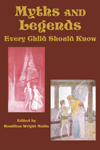
ISBN:
978-1-61720-122-6



|
|
|
|
|
|
|
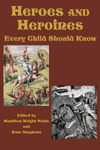 ISBN: ISBN:
978-1-61720-123-3


 |
“Heroes and
Heroines Every Child Should Know”
— From very early times great honor was paid to courage and strength;
qualities which won success and impressed the imagination. The first
heroes and heroines were gods or demi-gods, or others, who did
difficult things, not for themselves but for others. The men and women
whose bravery and great deeds are described in these pages have been
selected not because they are faultless in character and life, but
because they were brave, generous, self-forgetful, self- sacrificing
and capable of splendid deeds. Stories of heroes and heroines have
often made others strong and brave and true in the face of great perils
and tasks, and this book is put forth in the faith that it will not
only pass on the fame of the heroes and heroines of the past but help
make heroes and heroines in the present.
“Heroes Every Child Should Know”
is a collection of twenty stories about famous heros: Perseus,
Hercules, Daniel, David, St. George, King Arthur, Sir Galahad,
Siegfried, Roland, King Alfred, The Cid, Robin Hood, Richard the
Lion-Hearted, Saint Louis, William Tell, Robert Bruce, George
Washington, Robert E. Lee, Abraham Lincoln, and Father Damien. These
men exemplify great courage and perseverance, struggling onward despite
great odds against them. Some succeed, some do not, yet they never lose
heart.
“Heroines Every Child Should Know”
similarly pulls together thirteen heroines: Alcestis, Antigone,
Iphigenia, Paula, Joan of Arc, Catherine Douglas, Lady Jane Grey,
Pocahontas, Flora Macdonald, Madame Roland, Grace Darling, Sister Dora,
and Florence Nightingale. While not as physically strong as the men,
these women show great mental and emotional strength, and set examples
for how to cope with great stress and criticisms, and how to persevere
when everyone else gives up.
“Heroes Tales Every Child Should
Know” and “Heroines
Every Child Should Know” were originally published in 1905
and 1908, respectively. This volume faithfully reproduces the stories
in those edition.
|
|
|
|
|
|
|
|
|
|
|
|
Page and contents
Copyright © 2012 by Terry Kepner, All Rights Reserved
Book Covers displayed on this page are Copyright © 2008, 2009, 2010,
2011, 2012 by
Terry Kepner, All Rights Reserved
(please
notify "tkepner" at "aol.com" if you notice any broken links)

|
|


























